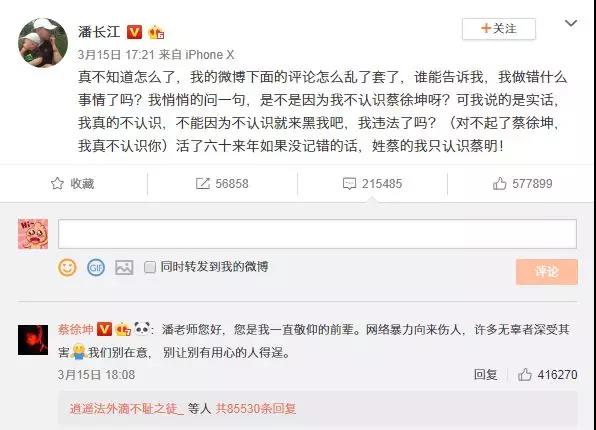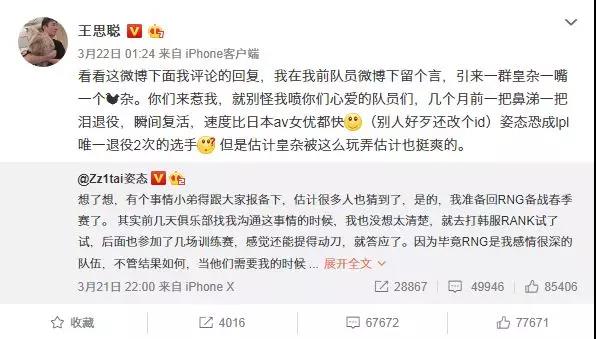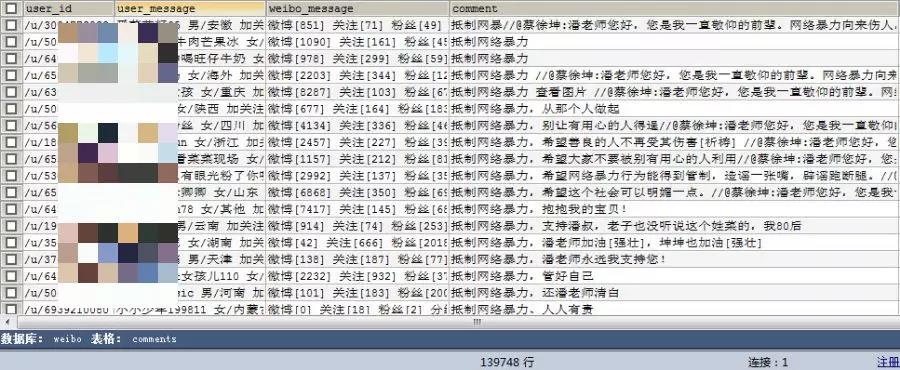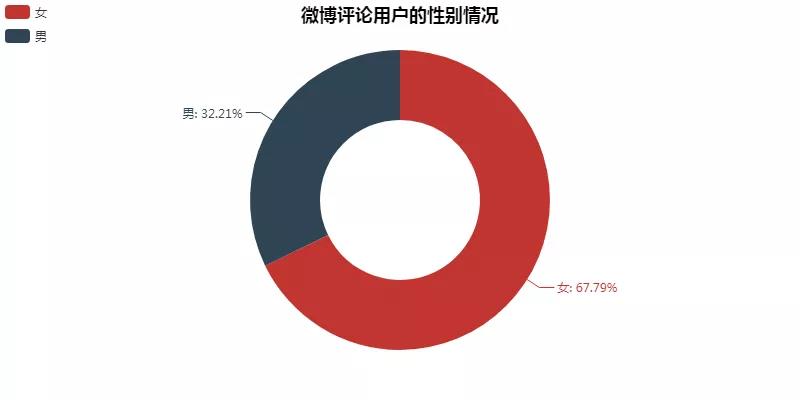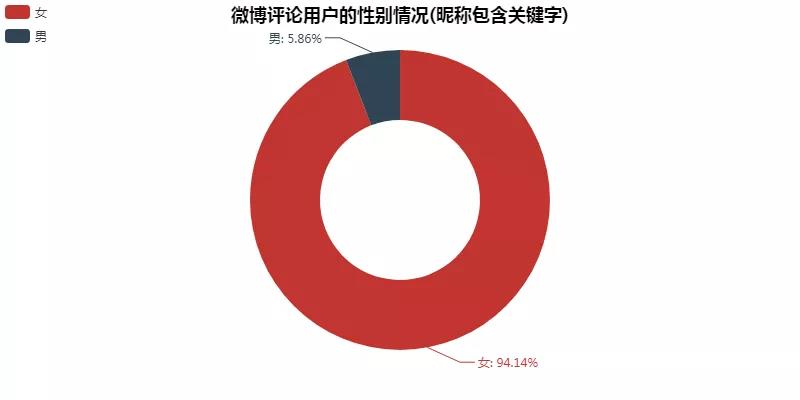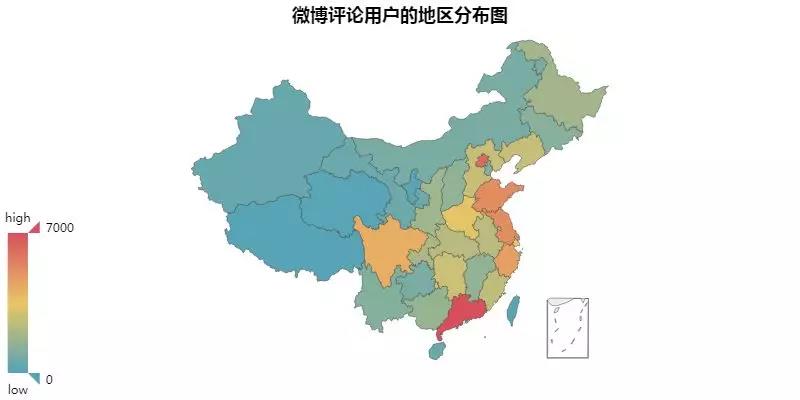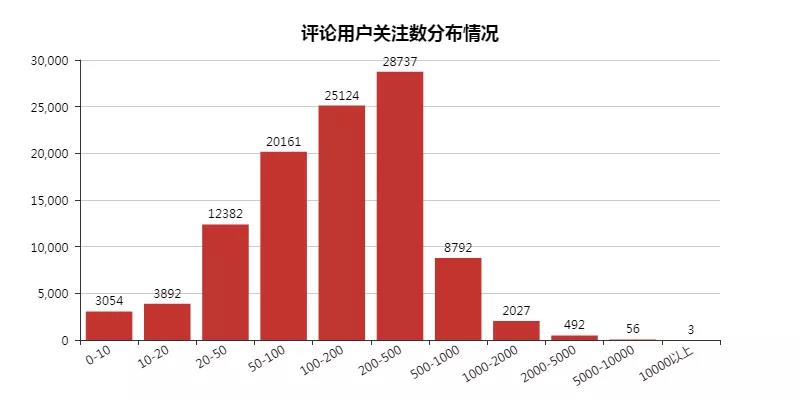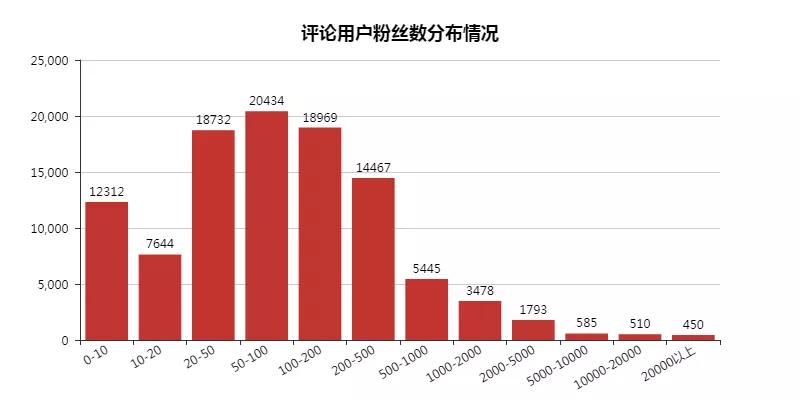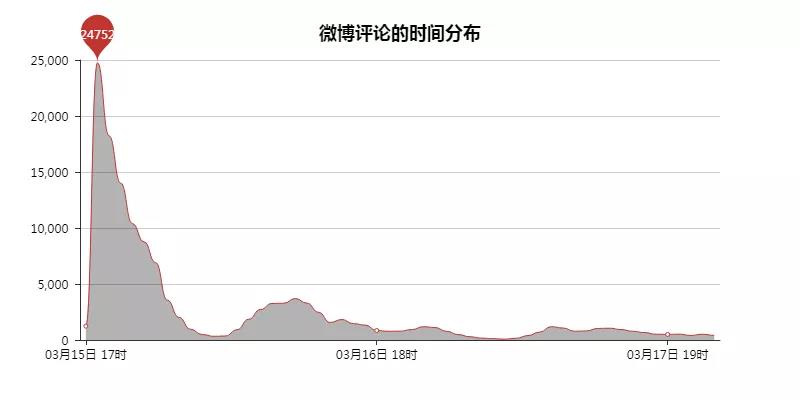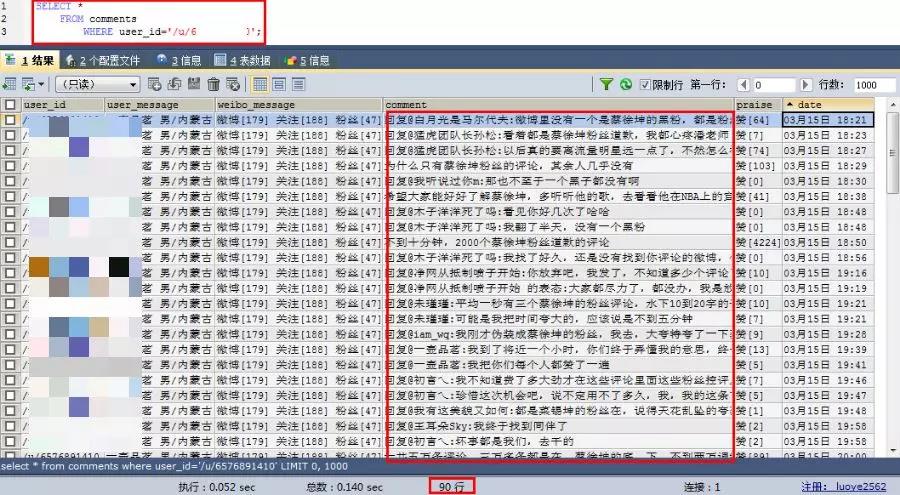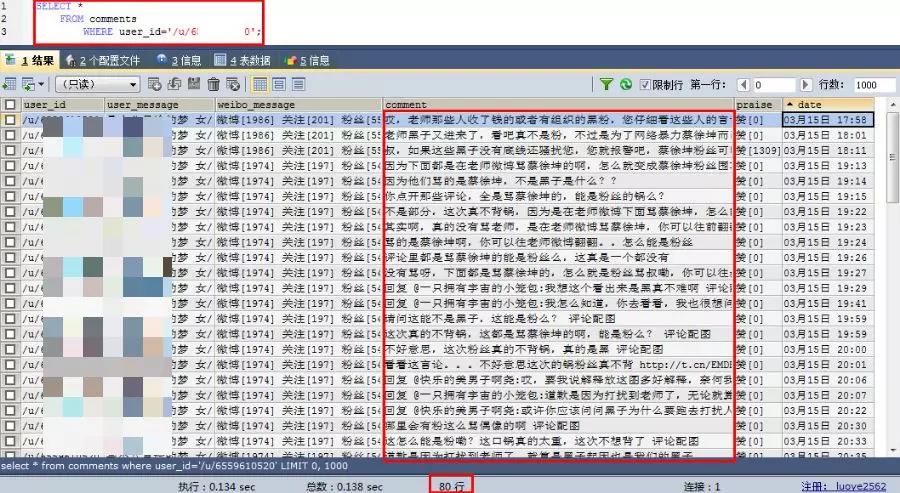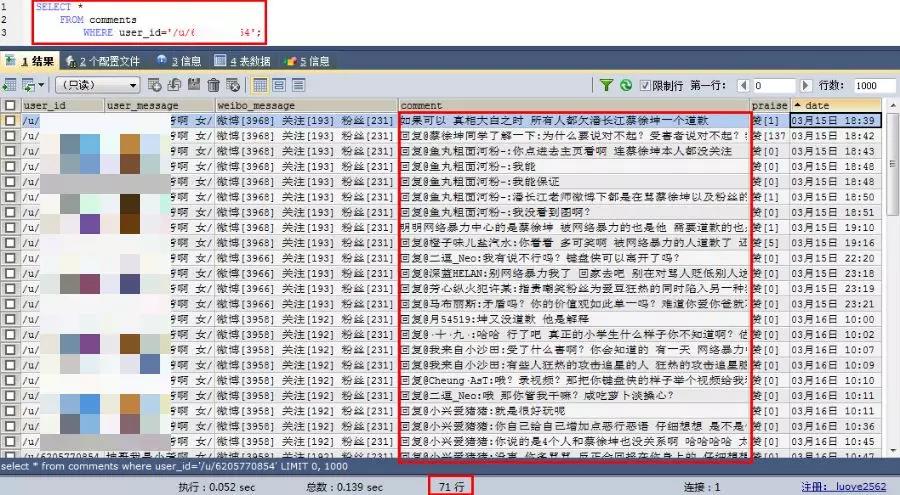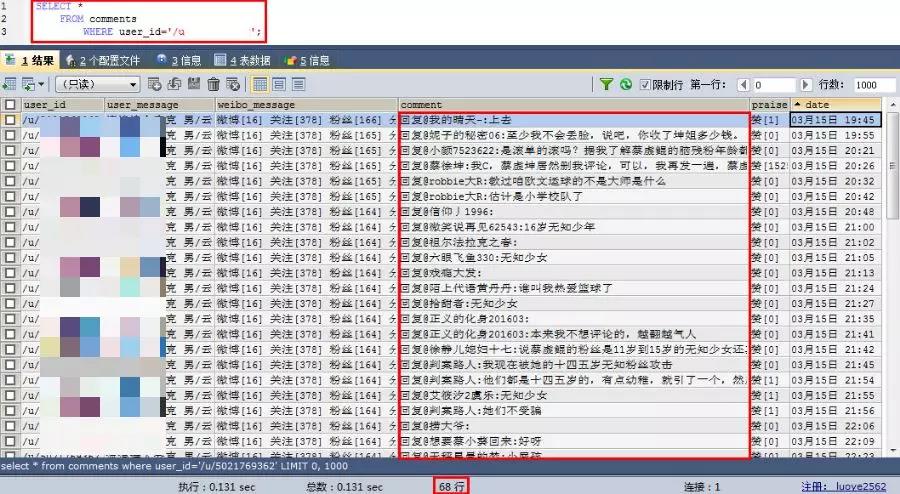用數據分析網絡暴力有多可怕
這應該是一篇拖得蠻久的文章。
故事源于潘長江在某個綜藝節目上沒認出蔡徐坤,然后潘長江老師的微博評論區就炸鍋了。
***搞得兩邊都多多少少受到網絡暴力的影響。
直至今日,這條微博的評論區還在更新著。
不得不說微博的黑粉,強行帶節奏,真的很可怕。
還有比如自己一直關注的英雄聯盟。
上周王校長也是被帶了一波節奏,源于姿態退役后又復出的一條微博。
本來是一句很普通的調侃回復,「離辣個傳奇adc的回歸,還遠嗎?[二哈]」。
然后就有人開始帶王校長的節奏,直接把王校長給惹毛了。
上面這些事情,對于我這個吃瓜群眾,也沒什么好說的。
只是希望以后能沒有那么多無聊的人去帶節奏,強行給他人帶來壓力。
本次通過獲取潘長江老師那條微博的評論用戶信息,來分析一波。
一共是獲取了3天的評論,共14萬條。
一、前期工作
微博評論信息獲取就不細說,之前也講過了。
這里提一下用戶信息獲取,同樣從移動端下手。
主要是獲取用戶的昵稱、性別、地區、微博數、關注數、粉絲數。
另外本次的數據存儲采用MySQL數據庫。
創建數據庫。
- import pymysql
- db = pymysql.connect(host='127.0.0.1', user='root', password='774110919', port=3306)
- cursor = db.cursor()
- cursor.execute("CREATE DATABASE weibo DEFAULT CHARACTER SET utf8mb4")
- db.close()
創建表格以及設置字段信息。
- import pymysql
- db = pymysql.connect(host='127.0.0.1', user='root', password='774110919', port=3306, db='weibo')
- cursor = db.cursor()
- sql = 'CREATE TABLE IF NOT EXISTS comments (user_id VARCHAR(255) NOT NULL, user_message VARCHAR(255) NOT NULL, weibo_message VARCHAR(255) NOT NULL, comment VARCHAR(255) NOT NULL, praise VARCHAR(255) NOT NULL, date VARCHAR(255) NOT NULL, PRIMARY KEY (comment, date))'
- cursor.execute(sql)
- db.close()
二、數據獲取
具體代碼如下。
- from copyheaders import headers_raw_to_dict
- from bs4 import BeautifulSoup
- import requests
- import pymysql
- import re
- headers = b"""
- accept:text/html,application/xhtml+xml,application/xml;q=0.9,image/webp,image/apng,*/*;q=0.8
- accept-encoding:gzip, deflate, br
- accept-language:zh-CN,zh;q=0.9
- cache-control:max-age=0
- cookie:你的參數
- upgrade-insecure-requests:1
- user-agent:Mozilla/5.0 (Windows NT 6.1; WOW64) AppleWebKit/537.36 (KHTML, like Gecko) Chrome/63.0.3239.132 Safari/537.36
- """
- # 將請求頭字符串轉化為字典
- headers = headers_raw_to_dict(headers)
- def to_mysql(data):
- """
- 信息寫入mysql
- """
- table = 'comments'
- keys = ', '.join(data.keys())
- values = ', '.join(['%s'] * len(data))
- db = pymysql.connect(host='localhost', user='root', password='774110919', port=3306, db='weibo')
- cursor = db.cursor()
- sql = 'INSERT INTO {table}({keys}) VALUES ({values})'.format(table=table, keys=keys, values=values)
- try:
- if cursor.execute(sql, tuple(data.values())):
- print("Successful")
- db.commit()
- except:
- print('Failed')
- db.rollback()
- db.close()
- def get_user(user_id):
- """
- 獲取用戶信息
- """
- try:
- url_user = 'https://weibo.cn' + str(user_id)
- response_user = requests.get(url=url_user, headers=headers)
- soup_user = BeautifulSoup(response_user.text, 'html.parser')
- # 用戶信息
- re_1 = soup_user.find_all(class_='ut')
- user_message = re_1[0].find(class_='ctt').get_text()
- # 微博信息
- re_2 = soup_user.find_all(class_='tip2')
- weibo_message = re_2[0].get_text()
- return (user_message, weibo_message)
- except:
- return ('未知', '未知')
- def get_message():
- # ***頁有熱門評論,拿取信息較麻煩,這里偷個懶~
- for i in range(2, 20000):
- data = {}
- print('第------------' + str(i) + '------------頁')
- # 請求網址
- url = 'https://weibo.cn/comment/Hl2O21Xw1?uid=1732460543&rl=0&page=' + str(i)
- response = requests.get(url=url, headers=headers)
- html = response.text
- soup = BeautifulSoup(html, 'html.parser')
- # 評論信息
- comments = soup.find_all(class_='ctt')
- # 點贊數
- praises = soup.find_all(class_='cc')
- # 評論時間
- date = soup.find_all(class_='ct')
- # 獲取用戶名
- name = re.findall('id="C_.*?href="/.*?">(.*?)</a>', html)
- # 獲取用戶ID
- user_ids = re.findall('id="C_.*?href="(.*?)">(.*?)</a>', html)
- for j in range(len(name)):
- # 用戶ID
- user_id = user_ids[j][0]
- (user_message, weibo_message) = get_user(user_id)
- data['user_id'] = " ".join(user_id.split())
- data['user_message'] = " ".join(user_message.split())
- data['weibo_message'] = " ".join(weibo_message.split())
- data['comment'] = " ".join(comments[j].get_text().split())
- data['praise'] = " ".join(praises[j * 2].get_text().split())
- data['date'] = " ".join(date[j].get_text().split())
- print(data)
- # 寫入數據庫中
- to_mysql(data)
- if __name__ == '__main__':
- get_message()
***成功獲取評論信息。
3天14萬條評論,著實可怕。
有時我不禁在想,到底是誰天天會那么無聊去刷評論。
職業黑粉,職業水軍嗎?好像還真的有。
三、數據清洗
清洗代碼如下。
- import pandas as pd
- import pymysql
- # 設置列名與數據對齊
- pd.set_option('display.unicode.ambiguous_as_wide', True)
- pd.set_option('display.unicode.east_asian_width', True)
- # 顯示10列
- pd.set_option('display.max_columns', 10)
- # 顯示10行
- pd.set_option('display.max_rows', 10)
- # 設置顯示寬度為500,這樣就不會在IDE中換行了
- pd.set_option('display.width', 2000)
- # 讀取數據
- conn = pymysql.connect(host='localhost', user='root', password='774110919', port=3306, db='weibo', charset='utf8mb4')
- cursor = conn.cursor()
- sql = "select * from comments"
- db = pd.read_sql(sql, conn)
- # 清洗數據
- df = db['user_message'].str.split(' ', expand=True)
- # 用戶名
- df['name'] = df[0]
- # 性別及地區
- df1 = df[1].str.split('/', expand=True)
- df['gender'] = df1[0]
- df['province'] = df1[1]
- # 用戶ID
- df['id'] = db['user_id']
- # 評論信息
- df['comment'] = db['comment']
- # 點贊數
- df['praise'] = db['praise'].str.extract('(\d+)').astype("int")
- # 微博數,關注數,粉絲數
- df2 = db['weibo_message'].str.split(' ', expand=True)
- df2 = df2[df2[0] != '未知']
- df['tweeting'] = df2[0].str.extract('(\d+)').astype("int")
- df['follows'] = df2[1].str.extract('(\d+)').astype("int")
- df['followers'] = df2[2].str.extract('(\d+)').astype("int")
- # 評論時間
- df['time'] = db['date'].str.split(':', expand=True)[0]
- df['time'] = pd.Series([i+'時' for i in df['time']])
- df['day'] = df['time'].str.split(' ', expand=True)[0]
- # 去除無用信息
- df = df.ix[:, 3:]
- df = df[df['name'] != '未知']
- df = df[df['time'].str.contains("日")]
- # 隨機輸出10行數據
- print(df.sample(10))
輸出數據。
隨機輸出十條,就大致能看出評論區是什么畫風了。
四、數據可視化
01 評論用戶性別情況
通過用戶ID對數據去重后,剩下約10萬+用戶。
***張圖為所有用戶的性別情況,其中男性3萬+,女性7萬+。
這確實也符合蔡徐坤的粉絲群體。
第二張圖是因為之前看到「Alfred數據室」對于蔡徐坤粉絲群體的分析。
提到了很多蔡徐坤的粉絲喜歡用帶有「坤、蔡、葵、kun」的昵稱。
所以將昵稱包含這些字的用戶提取出來。
果不其然,女性1.2萬+,男性900+,更加符合了蔡徐坤的粉絲群體。
可視化代碼如下。
- from pyecharts import Pie, Map, Line
- def create_gender(df):
- # 全部用戶
- # df = df.drop_duplicates('id')
- # 包含關鍵字用戶
- df = df[df['name'].str.contains("坤|蔡|葵|kun")].drop_duplicates('id')
- # 分組匯總
- gender_message = df.groupby(['gender'])
- gender_com = gender_message['gender'].agg(['count'])
- gender_com.reset_index(inplace=True)
- # 生成餅圖
- attr = gender_com['gender']
- v1 = gender_com['count']
- # pie = Pie("微博評論用戶的性別情況", title_pos='center', title_top=0)
- # pie.add("", attr, v1, radius=[40, 75], label_text_color=None, is_label_show=True, legend_orient="vertical", legend_pos="left", legend_top="%10")
- # pie.render("微博評論用戶的性別情況.html")
- pie = Pie("微博評論用戶的性別情況(昵稱包含關鍵字)", title_pos='center', title_top=0)
- pie.add("", attr, v1, radius=[40, 75], label_text_color=None, is_label_show=True, legend_orient="vertical", legend_pos="left", legend_top="%10")
- pie.render("微博評論用戶的性別情況(昵稱包含關鍵字).html")
02 評論用戶區域分布
廣東以8000+的評論用戶居于首位,隨后則是北京、山東,江蘇,浙江,四川。
這里也與之前網易云音樂評論用戶的分布有點相似。
更加能說明這幾個地方的網民不少。
可視化代碼如下。
- def create_map(df):
- # 全部用戶
- df = df.drop_duplicates('id')
- # 分組匯總
- loc_message = df.groupby(['province'])
- loc_com = loc_message['province'].agg(['count'])
- loc_com.reset_index(inplace=True)
- # 繪制地圖
- value = [i for i in loc_com['count']]
- attr = [i for i in loc_com['province']]
- map = Map("微博評論用戶的地區分布圖", title_pos='center', title_top=0)
- map.add("", attr, value, maptype="china", is_visualmap=True, visual_text_color="#000", is_map_symbol_show=False, visual_range=[0, 7000])
- map.render('微博評論用戶的地區分布圖.html')
03 評論用戶關注數分布
整體上符合常態,不過我也很好奇那些關注上千的用戶,是什么樣的一個存在。
可視化代碼如下。
- def create_follows(df):
- """
- 生成評論用戶關注數情況
- """
- df = df.drop_duplicates('id')
- follows = df['follows']
- bins = [0, 10, 20, 50, 100, 200, 500, 1000, 2000, 5000, 10000, 20000]
- level = ['0-10', '10-20', '20-50', '50-100', '100-200', '200-500', '500-1000', '1000-2000', '2000-5000', '5000-10000', '10000以上']
- len_stage = pd.cut(follows, bins=bins, labels=level).value_counts().sort_index()
- # 生成柱狀圖
- attr = len_stage.index
- v1 = len_stage.values
- bar = Bar("評論用戶關注數分布情況", title_pos='center', title_top='18', width=800, height=400)
- bar.add("", attr, v1, is_stack=True, is_label_show=True, xaxis_interval=0, xaxis_rotate=30)
- bar.render("評論用戶關注數分布情況.html")
04 評論用戶粉絲數分布
這里發現粉絲數為「0-10」的用戶不少,估摸著應該是水軍在作怪了。
粉絲數為「50-100」的用戶最多。
可視化代碼如下。
- def create_follows(df):
- """
- 生成評論用戶關注數情況
- """
- df = df.drop_duplicates('id')
- follows = df['follows']
- bins = [0, 10, 20, 50, 100, 200, 500, 1000, 2000, 5000, 10000, 20000]
- level = ['0-10', '10-20', '20-50', '50-100', '100-200', '200-500', '500-1000', '1000-2000', '2000-5000', '5000-10000', '10000以上']
- len_stage = pd.cut(follows, bins=bins, labels=level).value_counts().sort_index()
- # 生成柱狀圖
- attr = len_stage.index
- v1 = len_stage.values
- bar = Bar("評論用戶關注數分布情況", title_pos='center', title_top='18', width=800, height=400)
- bar.add("", attr, v1, is_stack=True, is_label_show=True, xaxis_interval=0, xaxis_rotate=30)
- bar.render("評論用戶關注數分布情況.html")
05 評論時間分布
潘老師是在17時發出微博的,但是那時并沒有大量的評論出現,那個小時一共有1237條評論。
直到蔡徐坤在18時評論后,微博的評論一下就上去了,24752條。
而且目前一半的評論都是在蔡徐坤的回復底下評論,點贊數多的也大多都在其中。
不得不說蔡徐坤的粉絲力量真大,可怕可怕~
可視化代碼如下。
- def creat_date(df):
- # 分組匯總
- date_message = df.groupby(['time'])
- date_com = date_message['time'].agg(['count'])
- date_com.reset_index(inplace=True)
- # 繪制走勢圖
- attr = date_com['time']
- v1 = date_com['count']
- line = Line("微博評論的時間分布", title_pos='center', title_top='18', width=800, height=400)
- line.add("", attr, v1, is_smooth=True, is_fill=True, area_color="#000", xaxis_interval=24, is_xaxislabel_align=True, xaxis_min="dataMin", area_opacity=0.3, mark_point=["max"], mark_point_symbol="pin", mark_point_symbolsize=55)
- line.render("微博評論的時間分布.html")
06 評論詞云
大體上言論還算好,沒有很偏激。
可視化代碼如下。
- from wordcloud import WordCloud, ImageColorGenerator
- import matplotlib.pyplot as plt
- import jieba
- def create_wordcloud(df):
- """
- 生成評論詞云
- """
- words = pd.read_csv('chineseStopWords.txt', encoding='gbk', sep='\t', names=['stopword'])
- # 分詞
- text = ''
- for line in df['comment']:
- line = line.split(':')[-1]
- text += ' '.join(jieba.cut(str(line), cut_all=False))
- # 停用詞
- stopwords = set('')
- stopwords.update(words['stopword'])
- backgroud_Image = plt.imread('article.jpg')
- wc = WordCloud(
- background_color='white',
- mask=backgroud_Image,
- font_path='C:\Windows\Fonts\華康儷金黑W8.TTF',
- max_words=2000,
- max_font_size=150,
- min_font_size=15,
- prefer_horizontal=1,
- random_state=50,
- stopwords=stopwords
- )
- wc.generate_from_text(text)
- img_colors = ImageColorGenerator(backgroud_Image)
- wc.recolor(color_func=img_colors)
- # 高詞頻詞語
- process_word = WordCloud.process_text(wc, text)
- sort = sorted(process_word.items(), key=lambda e: e[1], reverse=True)
- print(sort[:50])
- plt.imshow(wc)
- plt.axis('off')
- wc.to_file("微博評論詞云.jpg")
- print('生成詞云成功!')
五、總結
***,照例來扒一扒哪位用戶評論最多。
這位男性用戶,一共評論了90條,居于首位。
評論畫風有點迷,是來攪局的嗎?
這位女性用戶,一共評論了80條。
大部分內容都是圍繞黑粉去說的。
這位女性用戶,一共評論了71條。
瘋狂與評論區互動...
這位男性用戶,一共評論了68條。
也在與評論區互動,不過大多數評論情感傾向都是偏消極的。
觀察了評論數最多的10名用戶,發現其中男性用戶的評論都是偏負面的,女性評論都是正面的。
好了,作為一名吃瓜群眾,我是看看就好,也就不發表什么言論了。














